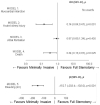Optimizing Aortic Valve Reoperations: Ministernotomy vs. Full Sternotomy
- PMID: 40004743
- PMCID: PMC11856763
- DOI: 10.3390/jcm14041213
Optimizing Aortic Valve Reoperations: Ministernotomy vs. Full Sternotomy
Abstract
Background: The minimally invasive approach, performed via ministernotomy, is now often preferred for isolated aortic valve replacement (AVR). However, its benefits in patients with prior cardiac surgery remain unclear. This article compares traditional and minimally invasive surgery for isolated aortic valve replacement in reoperative cases. Methods: A retrospective analysis of 382 patients who underwent reoperative AVR between January 2010 and June 2024 divided them into two groups: 309 patients (80.1%) had a traditional full sternotomy, while 73 patients (19.1%) had minimally invasive AVR via upper ministernotomy. Results: Significant differences were noted between the groups. The full sternotomy group had a higher logistic EuroSCORE (SMD = 0.203), more patients with active endocarditis (SMD = 0.312), and a higher pacemaker rate. To minimize bias, inverse probability of treatment weighting (IPTW) was used. The minimally invasive group had shorter aortic cross-clamp (50 vs. 65 min, p < 0.001) and cardiopulmonary bypass times (62 vs. 85 min, p < 0.001), shorter intensive care unit (ICU) stays (p < 0.001), lower rates of acute renal failure (p = 0.001), and less blood loss (p < 0.001), but similar transfusion needs. Early mortality was higher in the full sternotomy group (4.5% vs. 1.6%, p = 0.025). Conclusions: Minimally invasive aortic valve reoperation via upper "J" sternotomy is as safe as full sternotomy. Patients experienced lower rates of acute renal failure and less postoperative bleeding, contributing to a safer recovery with decreased hospital mortality.
Keywords: aortic valve reoperation; minimally invasive surgery; reoperation; unclamped patent internal mammary artery.
Conflict of interest statement
Elisa Mikus reports a relationship with Corcym SRL that includes consultations and lectures. The other authors have no funding sources to disclose. The funders had no role in the design of the study; in the collection, analyses, or interpretation of data; in the writing of the manuscript; or in the decision to publish the results.
Figures
References
-
- Khalid S., Hassan M., Ali A., Anwar F., Siddiqui M.S., Shrestha S. Minimally invasive approaches versus conventional sternotomy for aortic valve replacement in patients with aortic valve disease: A systematic review and meta-analysis of 17,269 patients. Ann. Med. Surg. 2024;86:4005–4014. doi: 10.1097/MS9.0000000000002204. - DOI - PMC - PubMed
-
- Woldendorp K., Doyle M.P., Bannon P.G., Misfeld M., Yan T.D., Santarpino G., Berretta P., Di Eusanio M., Meuris B., Cerillo A.G., et al. Aortic valve replacement using stented or sutureless/rapid deployment prosthesis via either full-sternotomy or a minimally invasive approach: A network meta-analysis. Ann. Cardiothorac. Surg. 2020;9:347–363. doi: 10.21037/acs-2020-surd-17. - DOI - PMC - PubMed
LinkOut - more resources
Full Text Sources



